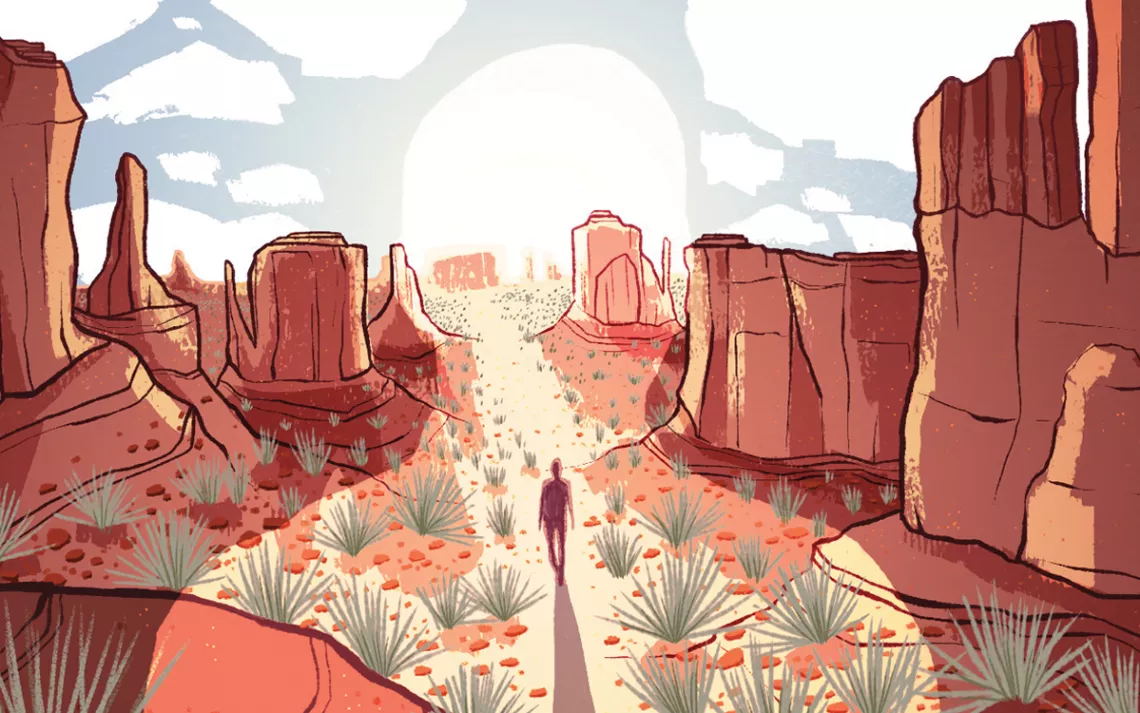A Search for Fossils Unearths a New Life
It felt like a test—how badly did I want this?

Illustration by Kailey Whitman
I wasn't prepared for snow. The Natural History Museum of Utah had planned its field expedition for spring break, but the pair of courting mule deer I accidentally scared was the only sign of spring. I'd brought along a leather jacket, just in case the night carried a little extra bite, but even in the sunshine it was a necessity, making me look like a punk rocker who had collapsed into an REI gear display then blearily wandered out into the desert.
I made it to camp just as the last scraps of scrambled eggs were being scraped off plates and hopped into one of the trucks. I'd been joining these expeditions for years, but I couldn't wait to be alone. Wobbly boulders, hidden rattlesnakes, and the potential for a wrenched ankle made looking for fossils in pairs a safer bet. But given more space than I could ever explore, I wanted to see what might be drawn out of myself. If "Riley" still felt right.
Everyone in camp called me Brian. Every time I thought about asking them to call me Riley, I felt a tremor of terror. There was no way I could talk about the change without explaining what had inspired it. I had been struggling with dysphoria for a long time, but I didn't know anyone else like me. Holding a camp meeting to introduce myself as a trans woman did not feel safe in the least.
When the trucks parked, I quickly grabbed my gear and started walking up the sun-beaten exposure. "Just two more days," I kept telling myself as I hiked, slid, and bouldered my way around the face of the Chinle Formation. Two more days until I could go to a Trans Health Program physician at the University of Utah and find out if I was a candidate for hormone-replacement therapy. Even making the appointment took endurance, weeks of navigating a labyrinth of phone numbers until I found someone who could book me an appointment. It felt like a first test. How badly did I want this?
At the top of the Chinle is an ancient boundary where a Triassic world dominated by crocodile relatives called pseudosuchians gave way to a world of dinosaurs as varied as mammalian life is today. That's where I found the tracks.
The story of the indentations was clear. Around 220 million years ago, a carnivorous dinosaur the size of an emu had strutted along the banks of a braided stream. I could practically hear the squelch of its three-toed feet. Over time, wind, sun, and, most of all, water had cut through the rock to pop the footsteps out, depositing them as if time itself had left them there and forgotten to pick them back up.
The same processes had created the entire canyon, and are still creating it. I could return the next year or the next day and the desert would not be the same. The red desert was as alive as I was. I thought of my personal topography. For the first few months, I knew, the changes would be imperceptible. Then fat would redistribute throughout my body. My skin would grow softer. At 36, I'd develop breasts.
I sat for a while at the peak, watching the rotation of Earth sift shadows across the tracks, freed of the stone that once encased them and left to tell their story. Paleontologists call the rock on top of fossils "overburden." It's the accumulation that obscures what you wish to see; you have to chip away to get down to what you hope to find. The overburden is almost never easy to remove. Sometimes it takes years to scrape away the stubborn stone.
I had made a discovery about myself. I'd started to peel back layers, suspicious that there was something beneath, something precious. With the Triassic mud on my boots and the red sand accumulating in my pack, I wondered how I, too, might change. What I might become with just enough time.
This article appeared in the May/June 2020 edition with the headline "Overburden."
 The Magazine of The Sierra Club
The Magazine of The Sierra Club



